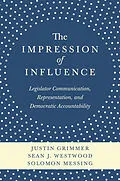Constituents often fail to hold their representatives accountable for federal spending decisions-even though those very choices have a pervasive influence on American life. Why does this happen? Breaking new ground in the study of representation, The Impression of Influence demonstrates how legislators skillfully inform constituents with strategic communication and how this facilitates or undermines accountability. Using a massive collection of Congressional texts and innovative experiments and methods, the book shows how legislators create an impression of influence through credit claiming messages.
Anticipating constituents' reactions, legislators claim credit for programs that elicit a positive response, making constituents believe their legislator is effectively representing their district. This spurs legislators to create and defend projects popular with their constituents. Yet legislators claim credit for much more-they announce projects long before they begin, deceptively imply they deserve credit for expenditures they had little role in securing, and boast about minuscule projects. Unfortunately, legislators get away with seeking credit broadly because constituents evaluate the actions that are reported, rather than the size of the expenditures.
The Impression of Influence raises critical questions about how citizens hold their political representatives accountable and when deception is allowable in a democracy.
Autorentext
Justin Grimmer is associate professor of political science at Stanford University. He is the author of Representational Style. Sean J. Westwood is a postdoctoral researcher at the Center for the Study of Democratic Politics at Princeton University. Solomon Messing is a research scientist with Facebook's Data Science Team.
Inhalt
List of Illustrations ix
List of Tables xi
Acknowledgments xiii
1 Representation, Spending, and the Personal Vote 1
2 Solving the Representative's Problem and Creating the Representative's Opportunity 15
3 How Legislators Create an Impression of Influence 32
4 Creating an Impression, Not Just Increasing Name Recognition 64
5 Cultivating an Impression of Influence with Actions and Small Expenditures 81
6 Credit, Deception, and Institutional Design 121
7 Criticism and Credit: How Deficit Implications Undermine Credit Allocation 148
8 Representation and the Impression of Influence 174
9 Text as Data: Methods Appendix 186
Bibliography 189
Index 203
